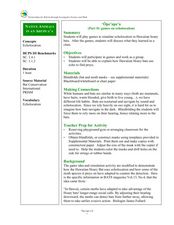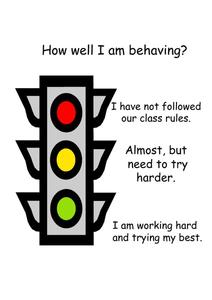Curated OER
Special Education Students in the Mainstream Classroom
How to prepare your mainstream students for a special education student in their classroom.
Curated OER
Pregnancy, Day 3: Prenatal Health
Focusing on prenatal health, this thorough resource provides discussion points about behaviors of the mother and of the father. It differentiates between controllable behaviors that help decrease problems with the developing fetus, and...
Curated OER
HIV/AIDS & Other STDs, Day 1: Germs & Risk
Assist your secondary special education class for understanding risky behavior, hygiene, and STDs. The class discusses how germs spread, how people get sick, and what needs to be done to prevent the spread of communicable diseases. They...
Curated OER
Token Economy: Template
The concept of token economy isn't new. Here is one of the oldest behavior management tools in the teacher box, and its all ready to go! It includes strip boxes, paper coins, and instructions on how to use them. I have used this type of...
Curated OER
Line Up Balls
At times special needs or Autistic children have a difficult time disengaging from a lesson to line up at the door. This brief strategy overview employs mini-porcupine balls and a pocket. It was developed to help pupils transition to...
Curated OER
Teen Jobs: How to Find, Get, and Keep Employment
A five-day lesson on getting and keeping a job; what could be more beneficial to a young adult? They'll discuss how to locate a job, pick up and fill out an application, and nail the all important job interview. Resume writing,...
Curated OER
Communication, Day 3: Asking What You Want
Mild to moderately disabled secondary students practice asking for what they want. They discuss a scenario, list things they want, then practice asking for those things. Our special needs students need to know how to communicate...
Curated OER
When Ants Fly
Here is a great lesson on constructing line graphs. Learners identify common characteristics of birds, ants common needs of all living things. They also write a story from the perspective of an ant or a bird that has lost its home and...
Curated OER
Graphical Analysis
Get out your TI-nspire graphing calculator and explore polynomials. Learners determine where a given polynomial are increasing or decreasing, find maximums, minimums, and zeros of polynomials, and discuss end behavior of polynomials....
Flipped Math
Calculus AB/BC - Exploring Behaviors of Implicit Relations
Put everything together implicitly. Pupils use their knowledge of implicit differentiation to determine whether a curve is increasing or decreasing or its concavity. Given a differential equation, scholars determine whether a specific...
Brain Parade
See.Touch.Learn.
Here is a great app that has tons of potential in helping your child or student with severe to moderate autism, or other intellectual disability, learn words and concepts using research-based methods. Children with autism or PDD NOS have...
Curriculum Corner
Data Binders
Here is a great resource to support students you have identified early on as needing behavioral or general learning support, particularly if you are practicing a Response to Intervention (RTI) approach. This data binder printable allows...
Curated OER
Games on Echolocation
Get a little batty with life science! This fun simulation game replicates how bats use echolocation to hunt moths in their native Hawaiian habitat. After creating blind folds and discussing some basic principles of echolocation, students...
Smithsonian Institution
Visiting a Museum
Imperial storm troopers make a special guest appearance in this resource designed as a behavior primer for young visitors to a museum.
Curated OER
Positive Behaviors of Strong Marriage Relationships
Students brainstorm a list of the characteristics they believe make a strong marriage. As a class, they are introduced to the actual characteristics and they compare them with their list. After watching a PowerPoint, they discuss the...
Floyd County Schools
Who Is Hibernating?
Young scientists explore the wintertime behavior of common animals with this presentation on hibernation. Offering clear explanations about the who, what, where, when, and why regarding hibernation, this resource is perfect for primary...
Curated OER
Wonderful World of Dinosaurs
Second graders obtain information about the characteristics of diet, locomotion, behavior, habitat, and anatomy of five dinosaurs by observing the Wonderful World of Dinosaurs HyperStudio presentation. They complete a student worksheet.
Curated OER
High Five
Young scholars discuss making choices, behavior and goals. In this responsibility lesson, students make list of goals they want to achieve. Young scholars share their lists with each other and decide if they make choices that help them...
Curated OER
Why Do People Fall in Love?
Students discuss human behavior, sexual selection and the underlying genetic and evolutionary reasons for mate selection. The, in groups, they rate the attractiveness of certain individuals and measure facial features for symmetry.
Curated OER
Good Training = Good Pets
Students examine animal behavior. In this animals training lesson, students understand a pet owner's responsibility for their pet's behavior. Students get into groups and brainstorm situations that pet's make a mistake that they are...
Curated OER
Criticism - The Great Inhibitor
Students explore how to handle criticism in the work place. In this conflict resolution lesson, students examine how criticism deters assertive behavior and role-play on how to respond to criticism in the work place.
Curated OER
You Can Stop!!
Students analyze smoking behavior based on peer pressure. In this health lesson plan, students read and complete worksheets on the internet concerning the behaviors associated with smoking. They summarize what they have learned by...
Curated OER
Reinforcement: Point/Sticker Cards
I love these! Print, cut, and laminate any of these sticker cards to help you manage classroom behavior in a positive way. Tape the blank chart on your learner's desk,or reward him by giving a point or sticker in each of the squares....
Primary Resources
How Well Am I Behaving?
Encourage self-monitoring of behavior with a packet of templates that encourage kids to monitor their own behavior. The red light on a traffic signal is for not following class rules, yellow says one has to try harder, and green means...

























